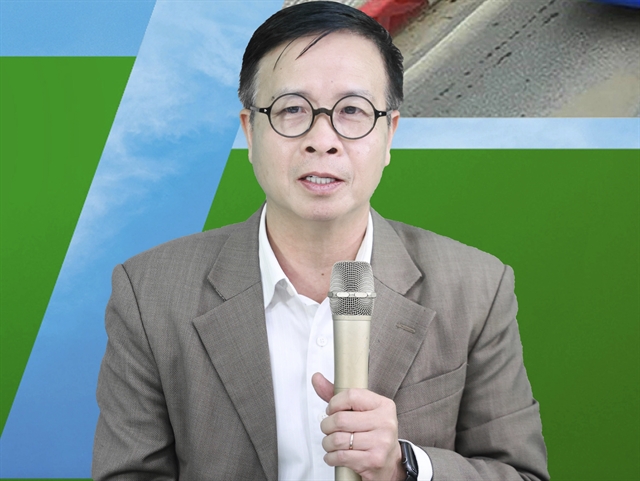 Opinion
Opinion

 |
| Nguyễn Hoàng Hải, vice president of the Public Transport Association. — Photo kinhtedothi.vn |
The management and control of budget funding for bus subsidies is one of the top concerns of Hà Nội. Nguyễn Hoàng Hải, vice president of the Hà Nội Public Transport Association talks with Kinh tế & Đô thị (Economic & Urban Affairs) newspaper about the issue.
How do you assess the bus subsidy policy in Hà Nội?
Subsidies were introduced very early and are a crucial policy to ensure the stable operation and gradual development of public transport by buses in Hà Nội.
Subsidies have positively influenced urban traffic in the capital, benefiting residents, businesses and management agencies, aiming towards a sustainable transportation model.
Low fares are currently one of the biggest advantages of buses, making this type of public transport attractive, thereby encouraging people to shift from private vehicles to buses, contributing to reducing traffic congestion and environmental pollution.
Recently, there have been concerns about the effectiveness of buses in general and subsidies in particular. What is your opinion?
In recent years, the management of subsidies has been consistently directed and closely monitored by the city and relevant departments. Essentially, the city's budget subsidises passengers through attractive fare systems and standardised pricing mechanisms.
The subsidy calculation formula is costs minus revenue, with the shortfall covered by the budget. It is clear that the subsidy budget has been used appropriately, strongly supporting the development of the bus network in the capital.
Scientific studies are needed to thoroughly and comprehensively evaluate the social effectiveness of bus subsidies in the capital.
In your opinion, does the bus subsidy policy have any limitations?
The bus subsidy policy in Hà Nội still has issues that need improvement. Currently, over 80 per cent of ticket prices are subsidised by the budget, but the allocation is not reasonably and accurately distributed to different passenger groups.
There is no precise control over output and revenue for each passenger group and each route, especially for passengers using single-ride, monthly, inter-route, priority and free tickets.
The initial steps of applying technology in bus management have been taken, but the level of digitalisation is not high and the database on drivers, vehicles and infrastructure is not promptly updated and processed.
Going forward, Hà Nội needs to continue adjusting the route network, implementing plans to transition to green buses and vigorously deploying smart management applications. These factors will impact input costs and company revenues.
These factors need to be fully updated, with specific and accurate calculation formulas to ensure correct and sufficient input costs when subsidising buses.
What is needed to manage and maximise the effectiveness of the bus subsidy policy?
I believe that three most important tools to manage, control, and enhance the effectiveness of Hà Nội's bus fare subsidy policy are to use electronic tickets, build detailed standardised pricing for each type of bus and carry out thorough inspection and supervision.
Especially in the current context, the application of technology in bus management and operation presents a significant opportunity to control and improve the efficiency of bus subsidies.
Hà Nội has applied electronic tickets on some bus routes, resulting in significant convenience for residents and passengers and good revenue control.
Additionally, we need to continue reviewing, completing and supplementing standardised pricing for each type of bus, such as regular buses, small electric buses, and natural gas buses.
This will be the basis for controlling bus input costs and is an important condition when organising route bidding and controlling subsidy volumes.
What else should be considered when subsidising buses?
In addition to the main solutions, we need to continue reviewing and improving the quality of network management, adjusting the ticket and fare structure suitable for different passenger groups.
Reviewing, updating and completing maintenance and repair processes, especially for electric buses and compressed natural gas (CNG) buses, adding new investment costs for buses and maintenance of new bus types.
Including technology investment items in the list of bus costs, reviewing and adjusting management processes when applying new technologies such as electronic tickets and intelligent transport system (ITS).
Depending on the speed and level of technological changes, we can adjust the subsidy calculation method in two phases. From now until 2030, we will continue the current subsidy calculation and management method.
From 2030 onwards, with the implementation of electronic tickets, ITS, and urban railways, subsidies should be directly provided to passengers with specific rates for different passenger groups such as single-ride tickets, priority tickets, and free tickets through the electronic ticketing system and the clearing centre.
It can be confirmed that subsidies play a very important role in maintaining and developing public transport in general and buses in particular, helping the city achieve major goals of limiting private vehicles, reducing traffic congestion risks and environmental pollution.
However, to further enhance effectiveness, subsidy management needs to continue improving, particularly in applying technology in managing and operating public transport. VNS




